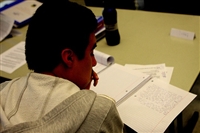

Writing critiques in the field of architecture and design

Writing a critique
In the field of Architecture and Design an important skill is being able to critique effectively. A critique may be oral or written. Both forms require an approach that includes elements of description, reflection, analysis and evaluation.
In these activities you will explore a student's written critique of a Virtual Space Theory blogpost. You will consider the kind of critiquing skills it reflects, and some useful language for this purpose. You will also practise writing a short critique yourself.
Activity 1: Recognising critiquing skills in a student commentary on a blog post
In this activity you are going to read an extract from a student's critique, written as part of her course assessment on her course in Architecture and Design. The student has chosen to comment on an article on a Virtual Space Theory blog. You are going to identify some of the critiquing skills that the student has used in her commentary.

Instruction
Open the link to the blog post and skim-read it first. Then read the extract from the student's critique below. Identify examples of the following different critiquing skills in her text. Copy them into the text areas and then read the feedback.
Extract from a student's critique:
On the Virtual Space Theory blog, the article "Improbable Urban Events" interested me. This article deals with the advertising industry, and the author explains to us how an improbable event can happen in the virtual world of TV commercials. The author does not explain all the marketing strategies which are used to make these ads, but the article is full of examples to show us things that can happen in virtual places and that cannot in reality. (...)These different examples use the same tool to share their messages: virtual cities. Even if the events are really different, they all take place in a virtual urban environments. Why do they do this? Because anything can happen in virtual spaces. Have you ever seen your childhood drawings taking life and walking in the streets? Not in your real city, but you can see it in the AT&T commercial's virtual world. Videos or places simulated in three dimensions are the new spaces where your dreams become true. People can imagine surrealistic events in virtual cities which look like regular environments to them. They can even build new buildings, or climb the Eiffel Tower, for example. To conclude, I would say that even if the author of this blogpost does not explain an opinion, he makes us realise with examples the power of virtual spaces, the power our imagination can have in these. This power is used in video commercials but it can be used in any field, where imaginations rules.
1. A sentence summarising what the author covers in their blog post article:
2. A sentence stating the scope/limitation of the article:
3. A reflective comment in the form of a rhetorical question:
4. A sentence containing the student's evaluation of the author's article, which includes a comment on its value and a constructive criticism:
5. A further comment, recognising how the scope of the author's perceptions can extend to other contexts:
Activity 2: Writing your own critique of a blog post
In this activity you are going to practise writing your own critique. As a focus for your critique, you are going to use a different post to the Vritual Space Theory blog. The post is entitled 'unlikely urban interventions'.

Instruction
Open the link to the second blog post and skim-read it. Make notes in the text area provided and use them to write your own short critique. Then read the feedback. Open the help section first if you would like a suggested structure to follow.
© Archi21 Project Consortium: Ecole Nationale Supérieure d'Architecture Paris-Malaquais, Open University, University of Ljubljana, Aalborg Universitet, University of Southampton and eLanguages, Modern Languages and Linguistics, University of Southampton, 2012. Image courtesy of Carlos Almendarez (Flickr).
This work is licensed under a Creative Commons Attribution-NonCommercial-NoDerivs CC BY-NC-ND Licence. 